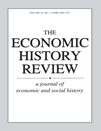Scrip as private money, monetary monopoly, and the rent-seeking state in Britain
Abstract
Scrip—promissory notes payable in goods at company stores—was issued by employers to pay workers, and was an important component of British money during the industrial revolution. As late as the third quarter of the nineteenth century, scrip issued by coal firms, which represented the foregone demand for official currency, was at least 9 to 24 per cent of the value of English country or Scottish banknote issues. In some areas, scrip was 38 per cent of the total wages paid. The state's suppression of this private currency to defend its seigniorage rents was in part the motivation behind the prohibition of the truck system in 1831.
Footnote references
- Ashton, T. S., ‘The bill of exchange and private banks in Lancashire, 1790–1830’, Economic History Review, 2nd ser., XV (1945), pp. 25–35.
- Ashton, T. S., An economic history of England: the eighteenthth century (New York, 1955).
- Batt, F. R. and Vaines, J. C., The law of master and servant ( 4th edn. 1950).
- Brechling, F. P. R. and Lipsey, R. G., ‘Trade credit and monetary policy’, Economic Journal, 73 (1963), pp. 618–41.
- Cameron, R., Banking in the early stages of industrialization: a study in comparative economic history (New York, 1967).
- Church, R., The history of the British coal industry, vol. 3, 1830–1913: Victorian pre-eminence (Oxford, 1986).
-
Collins, M., ‘Long-term growth of the English banking sector and money stock, 1844–80’, Economic History Review, 2nd ser., XXXVI (1983), pp.
374–94.
10.2307/2594971 Google Scholar
- Dawes, M. and Ward-Perkins, C. N., Country banks of England and Wales, vol. 1: private provincial banks and bankers 1688–1953 (Canterbury, 2000).
- Dyer, G. P. and Gaspar, P. P., ‘Reform, the new technology and Tower Hill, 1700–1966’, in C. E. Challis, ed., A new history of the Royal Mint (Cambridge, 1992), pp. 398–606.
- Engels, F., The condition of the working class in England (1987 [1st edn. 1844]).
- Feavearyear, A. E., The pound sterling: a history of English money (Oxford, 1931).
-
Fishback, P. V., Soft coal, hard choices: the economic welfare of bituminous coal miners, 1890–1930 (Oxford, 1992).
10.1093/acprof:oso/9780195067255.001.0001 Google Scholar
- Grampp, W. D., ‘The economists and the combination laws’, Quarterly Journal of Economics, 93 (1979), pp. 501–22.
- Gregory, T. E., Select statutes, documents and reports relating to British banking 1832–1928, vol. 1 (1964 [1st edn. 1929]).
- Hammond, J. L. and Hammond, B., The town labourer, 1760–1832 (1995 [1st edn. 1917]).
- Hicks, J., Critical essays in monetary theory (Oxford, 1967).
-
Hilton, G. W., ‘The Truck Act of 1831’, Economic History Review, 2nd ser., X (1958), pp.
470–9.
10.2307/2591266 Google Scholar
- Hilton, G. W., The truck system: including a history of the British Truck Acts, 1465–1960 (Cambridge, 1960).
- Horwitz, S., ‘Competitive currencies, legal restrictions, and the origins of the Fed: some evidence from the panic of 1907’, Southern Economic Journal, 56 (1990), pp. 639–49.
- Huffman, W. E. and Lothian, J. R., ‘Money in the United Kingdom, 1833–80’, Journal of Money, Credit and Banking, 12, 2, (1980). pp. 155–74.
- Mitchell, B. R., Economic development of the British coal industry, 1800–1914 (Cambridge, 1984).
- Mitchell, B. R., British historical statistics (Cambridge, 1988).
- Moss, D. J., ‘The Bank of England and the country banks: Birmingham, 1827–33’, Economic History Review, 2nd ser., XXXIV (1981), pp. 540–53.
- Polden, P., A history of the county court, 1846–1971 (Cambridge, 1999).
- Pressnell, L. S., Country banking in the industrial revolution (Oxford, 1956).
-
Rockoff, H., ‘The free banking era: a reexamination’, Journal of Money, Credit and Banking, 6, 2 (1974), pp.
141–67.
10.2307/1991023 Google Scholar
- Sargent, T. J. and Velde, F. R., The big problem of small change (Princeton, N.J., 2003).
- Selgin, G. A. and White, L. H., ‘How would the invisible hand handle money?’, Journal of Economic Literature, 32 (1994), pp. 1718–49.
- Sylla, R., ‘Forgotten men of money: private bankers in early US history’, Journal of Economic History, 36 (1976), pp. 173–88.
-
Tan, E. S., ‘Ideology, interest groups, and institutional change: the case of the British prohibition of wages in kind’, Journal of Institutional Economics, 1, 2 (2005), pp.
175–91.
10.1017/S1744137405000135 Google Scholar
- Tan, E., ‘Regulating wages in kind: theory and evidence from Britain’, Journal of Law, Economics, and Organization, 22 (2006), pp. 442–58.
- Timberlake, R., H., Jr., ‘The significance of unaccounted currencies’, Journal of Economic History, 41, (1981), pp. 853–66.
- Timberlake, R. H., ‘Private production of scrip-money in the isolated community’, Journal of Money, Credit and Banking, 19 (1987), pp. 437–47.
- Timberlake, R., ‘Scrip money’, in P. Newman, M. Milgate, and J. Eatwell, eds., New Palgrave dictionary of finance (1992), pp. 401–2.
- Unwin, G., Samuel Oldknow and the Arkwrights: the industrial revolution at Stockport and Marple (New York, 1968 [1st edn. 1924]).
- White, L. H., Free banking in Britain: theory, experience and debate, 1800–1845 (Cambridge, 1984).
- Williams, L., ‘The coalowners’, in D. Smith, ed., A people and a proletariat: essays in the history of Wales 1780–1980 (1980), pp. 94–113.




